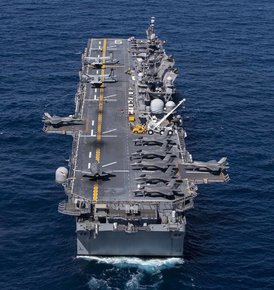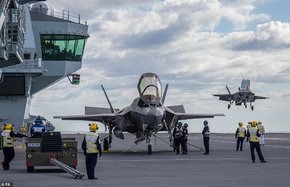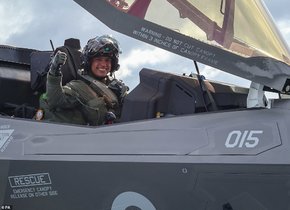Singapore joined the JSF Security cooperation programme in Feb 2003. But Singapore JSF programme went under the radar until around 2013 (when Dr Ng Eng Hen said in Parliament that his ministry was in the final stages of the evaluating the F-35) and the Jan 2020 approval by the US State Dept for the sale of up to 12 F-35Bs.
Perhaps half that is the likely the "flyaway" purchase cost...
The rest of the costs are... related to training, spares and support.
There will be costs incurred in the US associated with reprogramming center access, tanker support and setting up another RSAF fighter detachment in the US and this may be a factor in the ‘price’. Given that the infrastructure, such as simulators and other support equipment at bases like US Marine Corps Air Station (MCAS) Beaufort in South Carolina or MCAS Yuma in Arizona (where the US Marines base F-35Bs) will be specific to the aircraft to be acquired, the case for the RSAF setting up a training detachment at one of these bases is strong. The RSAF’s fifth detachment is likely to be there.
Training may also involve partnership programmes with friendly air forces that have purchased the F-35B variant – which on top of the US (353 F-35B) and UK (138 F-35B), include Italy. Italy will order 30 F-35Bs, which will be evenly split between the navy and air force.
In addition:
- Norway and Italy stood up a software lab at Eglin Air Force Base, Florida, allowing the two nations to manage its mission data separately from the US military. Italy was also working on hardware and software that would filter out sensitive F-35 data and keep it from being sent to the US.
- The VLO F-35B and the un-stealthy F-15SG both carry about the same amount of internal fuel — 13,326 lbs vs 13,550 lbs. But the F-15SG with CFT fitted have a fuel capacity of around 23,000 lbs before any optional external drop tanks are added. This F-35B acquisition gives the RSAF a Mach 1.6 (1,200 mph; 2,000 kph) STOVL fighter with an impressive range (when compared to the F-16V it replaces for the RSAF in the 2030s) before optional external drop tanks are added or taking into consideration, air-to-air refuelling.
Since I am uncertain how Singapore records certain defence acquisitions I do not know if that pricing might also cover modifications and/or expansions to current Singaporean defence infrastructure (hangars, heat treatments for runways/landing pads, etc.)
For land-scarce Singapore, merging three fighter airbases into two in the near future, this added capability provided by the F-35B will give the country a needed boost in its air power generation capabilities. Base improvement costs incurred in Singapore will not be published as declassified figures — as the project to close Paya Lebar Air Base at about 2030 and beyond, is well advanced in planning and upgrade works at
Tengah Air Base ongoing. The SAF’s current military airbases are located close to neighbouring states. For example, Tengah airbase is located only 6 kilometres from Malaysia and is vulnerable to attacks by swarms of drones, missiles or artillery fire. The successful attack on a Saudi Arabian oilfield by drones and cruise missiles in Sep 2019 highlights the vulnerability of Singapore’s airbases. According to
Mike Yeo:
“Singapore’s air bases will also change with the arrival of the F-35 in Singapore. This goes beyond the base realignment that has already been announced so far, which will see Paya Lebar Air Base close in the 2030s to free up land for other uses and the aircraft, equipment and personnel moved to the expanded Tengah and Changi East airbases.
Work at whichever base(s) the RSAF’s F-35s will be stationed at will also need to take into account US security requirements for F-35 basing. Essentially, an extra layer of fencing will need to be built around all F-35 parking areas, along with additional security arrangements. These include limiting access to these areas only to personnel specially cleared to enter, essentially turning it into an airbase within an airbase.
Another upgrade would entail the building of landing pads to allow F-35B pilots to conduct vertical landing training and operations on. These pads would need to be specially reinforced to withstand the intense downward heat generated by the F-35B’s powerful engine as it lands vertically.”
And lets not forget Trg includes going from conventional Jets to VSTOL Jets so in more ways than usual a very different Beast to what Singapore has operated before. We are not just talking about introducing a 5th Gen Fighter here but one with an extra unique capability as well.
Agreed.
Singapore’s forward defence strategy has now shifted focus to the maritime domain. A F-35B acquisition will eventually enable the 21st Division and its 7th Singapore Infantry Brigade (7 SIB), as an infantry formation specializing in heliborne and amphibious operations, supported by the future Joint-Multi-Mission Ship (JMMS) to operate more like a mini Marine expeditionary brigade (MEB) of the US Marines with its aviation combat element. Details of the JMMS are currently sketchy, but they will reportedly have double the capacity of the current Endurance Class vessels. The 7 SIB comprises of the Army Deployment Force, 1st Guards, 3rd Guards Battalions and a specialist C4I battalion — C4I stands for Command, Control, Communications, Computers, Intelligence Battalion. This was formed through the merger of Signals units and Intelligence, Surveillance and Reconnaissance (ISR) units of Army Intelligence. Over time SAF will declassify more of 7 SIB’s military capabilities with its spectrum of ISR capabilities and operations that include Operations Other than War. It will all become much clearer to both you and me — but I caution that a MEB has more assets than a heliborne and amphibious Singapore Brigade, so they will never be equivalent.
With regard to the JMMS (if it is based on the Endurance 160 design),
Mike Yeo has suggested the length of the flight deck is too short for F-35B operations (550ft/168m being the minimum for F-35B operations on a conventional flight deck) or the addition of a ski jump which would reduce the F-35B's take off distance to 450ft/137m.
Artillery threats, be they shells, mortars and rockets against Singapore main island has been around before Singapore gained her independence and during WWII, the crown colony was shelled by the Japanese Imperial Army. It is not something new and the SAF’s force structure is designed for forward defence to manage this threat. Learning from the US Marine Corps, dispersion of forward deployed Singapore forces via an
Expeditionary Advance Base, is possible using Naval and Air Force logistics capability present in Endurance class LPDs (to replaced by JMMS), Chinooks (eg. logistics and munitions lift) and the 6 A330 MRTT to sustain air patrols of the F-35Bs. A squadron of STOVL aircraft ensures that the RSAF can keep up combat air operations even in the event of it's runways being out of action, even for a short period of time. Knowing that the RSAF retains an air combat capability even without runways in operation would complicate any adversary's calculations in attempting a first strike to negate Singapore's defences. Dispersion enables Singapore to utilise alternative airfields (eg. Pulau Sudong, Seletar Airport or Sembawang helicopter base) that were previously unsuited for fighter aircraft due to the limited runway length. This allows RSAF aircraft to conduct flight operations for several days from numerous sites like stretches of highway, or expeditionary airfields using matting (eg. San Carlos Harrier FOB, built by the British in 1982 on the Falkland Islands - the runway length was 260m long).
The 2 RSAF fighter bases located in the rear (at Tengah and Changi in Singapore) would provide logistical and maintenance support for ongoing operations and subsequent overhauling and repairing of aircraft. Since only some of the surveyed sites would be occupied, enemy targeting would be reduced to a complicated shell game. It is clear, the SAF is keen and capable of learning from the US Marines, their concept of operations and strive to inter-operate with them at a joint service level (eg. on 9 February 1991, US Marines AV-8B Harriers operated out of a forward site at Tanajib, less than 40 miles from ground operations, to support Operation Desert Storm; Tanajib was an oil field support base that had an airstrip but this was expanded by the use of matting for taxiways and aircraft parking).






